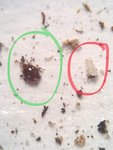Starfox
Masterpiece
Hey all,
I'm doing some weeding of this horrible weed that is coming up in a lot of my pots and in this one pot in particular there are a load of these tiny white bug things.
They don't match with the root aphids on google so I'm not sure what they could be. They do move around so not like scale. Could they be young pill bugs even?
Any ideas on what they are and how worried I should be and the best way to treat it since it is below the surface of the soil?
Also an ID on the weed would be great too because it's a constant battle with that as well.


I'm doing some weeding of this horrible weed that is coming up in a lot of my pots and in this one pot in particular there are a load of these tiny white bug things.
They don't match with the root aphids on google so I'm not sure what they could be. They do move around so not like scale. Could they be young pill bugs even?
Any ideas on what they are and how worried I should be and the best way to treat it since it is below the surface of the soil?
Also an ID on the weed would be great too because it's a constant battle with that as well.





